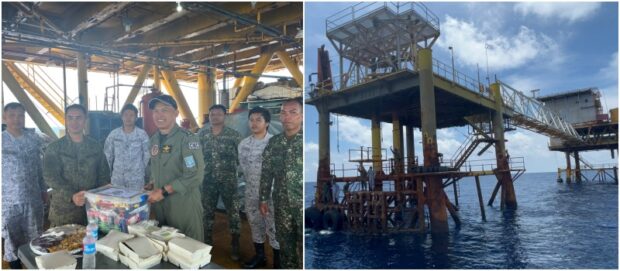
WELCOME BREAK | Soldiers assigned to the Nido observation post, a former gas platform turned over to the Armed Forces of the Philippines in 2019, are treated to food on Aug. 22, 2023, by visiting officers of the Western Command. (Photo by FRANCES MANGOSING / Philippine Daily Inquirer)
EL NIDO, Palawan, Philippines — The passing of each day is slow and tedious for a small group of soldiers deployed to the Nido observation post, a former gas platform that has been turned into a military outpost located northwest of this island province.
In between shifts, there is not much to do to pass the time except go fishing, exercise, watch television, or surf the internet depending on the limited power supply provided by generators.
For a period ranging from a month to half a year, the soldiers spend the day monitoring ships passing through the area. But Chinese ships, which have been brazenly encroaching on the country’s exclusive economic zone and blocking supply missions in Ayungin (Second Thomas) Shoal, are a rare sight here.
Western Command (Wescom) chief Vice Adm. Alberto Carlos, the top military commander overseeing Palawan and the country’s claims in the West Philippine Sea, calls the Nido observation post “the other BRP Sierra Madre,” referring to the grounded warship that serves as a military outpost in Ayungin.
Potential station
On Aug. 22, the Inquirer joined a visit led by Carlos and Joint Task Force (JTF) Malampaya commander Capt. Brendo Casaclang to the former gas platform to check on the troops stationed there.
The Nido observation post, located 68.5 kilometers (37 nautical miles) off El Nido, is one of two decommissioned gas platforms that have been converted into military outposts under the supervision of JTF Malampaya, one of the units under Wescom responsible for securing the commercial operations of the Malampaya natural gas power plant that provides 40 percent of Luzon’s power needs.
The other is the Matinloc observation post, located 52 km (28 nautical miles) off El Nido and around 11. 1 km (6 nautical miles) from the Malampaya gas field.
Both gas platforms were turned over to the Philippine Navy when they ceased operations in 2019 after being used for 40 years. If equipped with proper surveillance capabilities such as radars, the outposts would be crucial in monitoring air and surface traffic in the Palawan Passage, particularly near Malampaya gas field, Carlos told the Inquirer.
He added that the Nido observation post was also being considered as a potential location for a ground control station to extend the operational reach of unmanned aerial vehicles in the JTF Malampaya area of operations.
Just like the BRP Sierra Madre, the former gas platforms are located offshore, without any piece of land or sandbar surrounding them, making both outposts vulnerable to harsh weather conditions, according to Carlos.
Wescom complement
“The troops have limited space for living quarters and other amenities, in addition to the deteriorating condition of the said platforms,” he said.
The Wescom leadership’s visit to the Nido observation post was a welcome break in their monotonous daily routine, according to Seaman Second Class Jayson Motol, one of the troops assigned here.
The deployed soldiers, most of whom are not first-timers in the area, come from different service branches. They endure isolation just like in other lonely outposts across the archipelago but they all acknowledge that this is part of their duty.
According to Carlos, Wescom is currently overwhelmed by the daunting task of protecting the West Philippine Sea and Malampaya simultaneously, as he asked for more vessels and aircraft to be assigned to his unit.
“Considering the current scheme of deployment of assets at Western Command joint operational area, the command has limited capability in securing both the West Philippine Sea and Malampaya at the same time. The command needs a wide range of dedicated assets such as naval vessels, aircraft, and ground forces,” he told the Inquirer.
With most of the limited assets provided by the main military headquarters to Wescom focused on carrying out sovereign patrols and protecting the country’s claims in the West Philippine Sea, performing the equally important tasks of conducting maritime patrols and intelligence, surveillance, and reconnaissance operations in the Malampaya gas field exclusion and safety zones poses a challenge, Carlos said.
Wescom has been regularly training to secure Malampaya gas field from threats such as terrorism and piracy. But Carlos pointed out that a long-term security plan as well as a review of the current plan was needed.
In May, President Ferdinand Marcos Jr. signed an agreement extending the production contract for Malampaya gas field, which was set to expire in February 2024, by 15 more years.
Wescom will also be in charge of securing energy exploration projects off Palawan once the suspension that took effect last year is lifted by the government.

